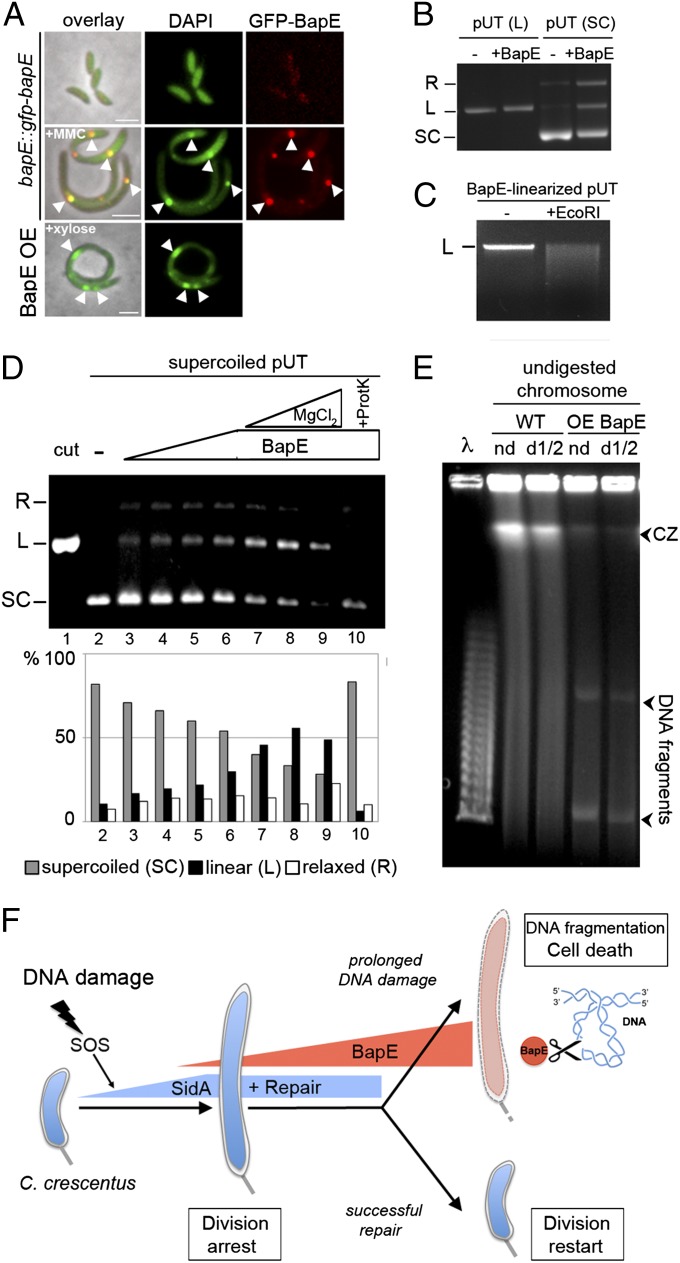Fig. 4.
BapE affects DNA integrity in vivo and in vitro. (A) Examination of chromosome morphology (DAPI staining) in cells expressing GFP-BapE from its endogenous promoter (bapE::gfp-bapE) grown either with or without MMC and in cells overexpressing BapE. White arrowheads indicate colocalization of GFP-BapE and bright foci of DNA. (B) Cut pUT plasmid (linearized with EcoRI) and uncut plasmid (supercoiled) DNA samples were incubated either with or without BapE protein. The topological states of pUT plasmid are indicated: SC, supercoiled; L, linear; and R, relaxed. (C) Purifed BapE-linearized pUT plasmid was incubated either with or without EcoRI restriction enzyme. The linear (L) state of pUT plasmid is indicated. (D) Supercoiled plasmid DNA (pUT) was incubated alone (lane 2), with increasing concentrations of BapE protein (0.16, 0.32, 0.54, and 0.82 μM) (lanes 3–6), with BapE protein (0.82 μM), and with increasing concentrations of MgCl2 (0.1, 0.5, and 1 mM) (lanes 7–9), and with BapE (0.82 μM) and proteinase K (lane 10). Cut (linear) plasmid is shown as a control (lane 1). Quantifications of the resulting plasmid topological states (SC, supercoiled; L, linear; and R, relaxed) are shown below the gel. (E) Analysis of in vivo chromosome fragmentation by pulsed-field gel electrophoresis of undigested Caulobacter chromosomes [nondiluted (nd) or 1/2 diluted (d1/2)] from cells with and without BapE overexpression. Arrowheads at the bottom denote linearized DNA fragments that are specifically obtained when BapE is overexpressed; arrowhead at the top indicates the compression zone (CZ) of intact high-molecular-weight DNA likely due to overloading of DNA. Lambda concatemers are used as molecular size markers. (F) Model of BapE-dependent DNA damage cell fate determination. In response to DNA damage, C. crescentus induces a graded expression of LexA-dependent genes. Early in the SOS response, cells induce the expression of the division inhibitor SidA (9) and DNA repair pathways to arrest cell division and give cells time to attempt to fix the damage. If DNA damage persists, cells induce the expression of the unique endonuclease, BapE, which functions as a cell fate determinant in a concentration-dependent manner: low levels of BapE reinforce the SidA-mediated reversible division arrest until cells succeed in repairing the damage and re-enter the cell cycle, whereas high levels of BapE promote apoptotic-like cell death by stimulating chromosome fragmentation in conditions of prolonged DNA damage.

